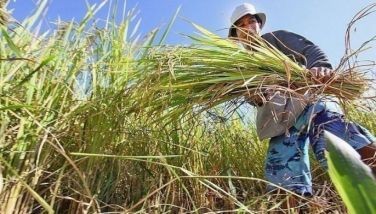Phl sets cadmium level standards for seafood exports
MANILA, Philippines - High-value seafoods produced in the Philippines are being subjected to cadmium exposure assessment to determine if the standards set by Codex Alimentarius can be achieved and likewise to set standards for our fishery products that are for export.
The cadmium exposure assessment is part of the project titled, “Achievable Levels of cadmium in Philippine Seafoods for Export,” implemented by the National Food Authority-Food Development Center (NFA-FDC) and funded by the Department of Agriculture-Bureau of Agricultural Research (DA-BAR).
Among the seafood samples considered in the project were those highly valued for export as identified and cited by the Bureau of Fisheries and Aquatic Resources (BFAR). These are: tuna, prawn, seaweeds (carageenan), crab, squid, sardines, and milkfish.
Reports showed that cadmium accumulates in all levels of food chain. In fact, the manner by which marine organisms accumulate cadmium through metabolic and biosorption process depends on the nature of the organism and the form of cadmium in aquatic environment.
The International Agency for Research on Cancer (IARC) classified cadmium and its compounds as carcinogenic to human. It can accumulate through consumption of seafoods that are contaminated with this heavy metal.
Only a small portion of cadmium can slowly leave the body through urine and feces, others can stay for years.
Unfortunately, the Codex General Standard for Contaminants and Toxins in Food and Feed, the international standard setting body has not established maximum levels (MLs) of cadmium for seafoods except for marine bivalves molluscs like clams, and mussels and cephalopods like cuttlefish, octopus, and squid. The ML for them is set at 2 mg/kg.
“If there is no ML for cadmium in fish, the Philippines may have a problem in the export market as importing countries may set very low levels or standards to which the country may not be able to comply,” explained Dr. Jocelyn M. Sales, project leader.
She said there is a need for generation of baseline data on the achievable levels of cadmium in Philippine seafoods for export to determine if the MLs set by Codex could be met by seafood products produced from the Philippines and it would not cause adverse effects on the consumers’ health.
“Through these important data, we can assess the risk of the proposed MLs of cadmium in fish and seafood products collected throughout the Philippine fishing grounds,” she stressed.
Specifically, the study seeks to: 1) Determine the cadmium levels in Philippine seafoods for export obtained from fishing grounds which are reportedly identified as near natural and anthropogenic or manmade sources of cadmium; 2) Establish the MLs of cadmium in seafoods that best reflect the position of the Philippines for recommendation, based on risk assessment, to CODEX; and 3) Identify the sources that have the greatest impact of cadmium contamination in selected Philippine seafoods including milkfish, crab, prawn and seaweeds.
Results of the study will be useful criteria on the outcome of risk assessment which will be utilized as a scientific tool for the establishment of MLs of cadmium in seafoods.
“The establishment of MLs will follow the procedure for assessment of the MLs of contaminants as set by Codex. Data will also be valuable for environmental assessment of heavy metal contamination brought about by natural and man-made causes,” said Dr. Sales.
Seafood samples that were considered in the project were taken from 13 identified sampling locations in regions 1, 2, 3, 4A, 4B, 5, 6, 7, 8, 9, 12, 13, and NCR.
Sampling locations considered were areas of major fishing grounds reported to have potential cadmium contamination from volcanic activity, mining, intensive agricultural practice of fertilizer application and high rate of pollution in air and water bodies; and areas where bulk of seafood species are cultured for export.
According to Dr. Sales, currently, the study is still ongoing and the group is continuing the analysis of 1,191 seafood samples. “We will conduct the exposure assessment to establish the proposed ML for each of the seafood species being studied, based on published consumption data,” she added.
The last stage of the study is the identification of the sources or factors that have the greatest impact of cadmium contamination in selected Philippine seafoods including milkfish, crab, prawn and seaweeds.
- Latest




























